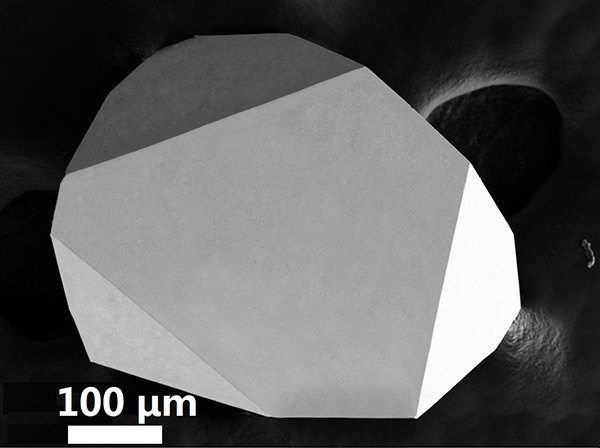New Material Discovered to Cool PCs and Mobile Devices
Boron arsenide crystals are being eyed as a material to manage heat in electronics like PCs and mobile devices.
July 30, 2018

Most people have had the experience of a laptop or mobile phone becoming hot to the touch after too much use. A team of researchers from several universities has come up with what it thinks is a solution to this problem by creating crystals of a semiconducting material called boron arsenide, which have an extremely high thermal conductivity.
The team—made up of researchers from the University of Texas at Dallas (UT Dallas), the University of Illinois at Urbana-Champaign, and the University of Houston—examined the problem of how to manage the heat of devices without the use of metal or cooling fans, which both have their drawbacks, said Bing Lv, assistant professor of physics in the School of Natural Sciences and Physics at UT Dallas.
“For high-powered, small electronics, we cannot use metal to dissipate heat because metal can cause a short circuit,” he said. “We cannot apply cooling fans because those take up space. What we need is an inexpensive semiconductor that also disperses a lot of heat.”
|
Researchers at the University of Texas at Dallas and their collaborators have created and characterized tiny crystals of boron arsenide that have high thermal conductivity. (Image source: UT Dallas) |
Designers of devices that rely on computer chips and transistors have long struggled to solve the problem of how to manage heat to keep it away from electronic circuitry and dissipate it to the outside environment. When computer chips overheat, programs can run slow or even freeze, the device can shut down altogether, or permanent damage may result from the excessive heat.
The key problem is that most of today's computer chips are made from silicon, which does an adequate job of dissipating heat. Even when paired with other cooling technology in devices, however, silicon has its limitations.
Diamond is the material with the highest-known thermal conductivity—at 2,200 watts per meter-kelvin, compared to about 150 watts per meter-kelvin for silicon. However, the high cost of the natural material and structural defects in man-made diamond films have made it impractical for widespread use, Lv said.
Based on 2013 research out of Boston College and the Naval Research Laboratory, Lv and his colleagues in 2015 turned to boron arsenide crystals as a solution to the problem. However, they found that the material they developed had a fairly low thermal conductivity, around 200 watts per meter-kelvin.
Researchers then set out to optimize the crystal-growing process to boost the material’s performance and in three years have seen significant results, Lv said.
“We … now have gotten the thermal conductivity up to about 1,000 watts per meter-kelvin, which is second only to diamond in bulk materials,” he said. “I think boron arsenide has great potential for the future of electronics. Its semiconducting properties are very comparable to silicon, which is why it would be ideal to incorporate boron arsenide into semiconducting devices.”
The team published a paper on its work in the journal Science.
Lv, working with postdoctoral research associate Dr. Sheng Li and physics doctoral student Xiaoyuan Liu, used a method called chemical vapor transport to create the high-thermal-conductivity crystals from raw materials--the elements boron and arsenic.
To develop the crystals, the researchers placed these materials in a chamber that is hot on one end and cold on the other. Inside the chamber, another chemical transports the boron and arsenic from the hot end to the cooler end, where the elements combine to form crystals.
“To jump from our previous results of 200 watts per meter-kelvin up to 1,000 watts per meter-kelvin, we needed to adjust many parameters, including the raw materials we started with, the temperature and pressure of the chamber, even the type of tubing we used and how we cleaned the equipment,” Lv said.
RELATED ARTICLES:
Researchers discovered that the way heat is dissipated in boron arsenide and other crystals is linked to the vibrations of the material. As the crystal vibrates, the motion creates packets of energy called phonons--or quasi-particles-- carrying heat. The unique features of boron-arsenide crystals, including the mass difference between the boron and arsenic atoms, allow for the ability of phonons to travel more efficiently away from the crystals, Lv said.
“I think boron arsenide has great potential for the future of electronics,” he said. “Its semiconducting properties are very comparable to silicon, which is why it would be ideal to incorporate boron arsenide into semiconducting devices.”
For those who worry about the toxicity of arsenic itself to humans, once the element is incorporated into a compound like boron arsenide, the material becomes very stable and nontoxic, Lv said.
Researchers plan to continue their work to experiment with other processes to improve the growth and properties of this material for large-scale applications, he said.
Elizabeth Montalbano is a freelance writer who has written about technology and culture for 20 years. She has lived and worked as a professional journalist in Phoenix, San Francisco and New York City. In her free time she enjoys surfing, traveling, music, yoga and cooking. She currently resides in a village on the southwest coast of Portugal.
|
About the Author(s)
You May Also Like





